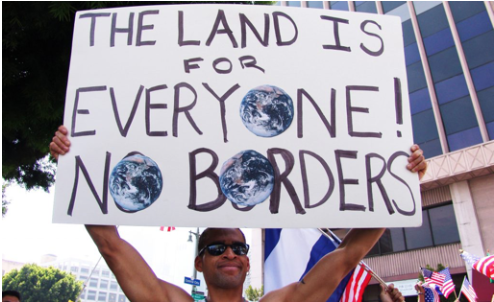CommentsDIVIDED ON THE BORDER-There are things that go unquestioned in the national discussion.
Because this is a country wrapped in fear and self-importance, the basic, unchallenged premise determining how we behave, how we spend our money, is that we need to protect ourselves … from The Enemy.
There’s always an enemy lurking at the core of our fear that is simplistic and human. The “enemy” is not, for instance, global warming, except in an abstract and basically meaningless sense, the defeat of which would require a collective global effort. Nor is the enemy nuclear disaster or accident, which could be addressed by (heaven forbid) disarmament.
Such solutions have enormous complexities, of course, but these complexities are not part of the national conversation, let alone the actions of government. Instead, we choose to arm — that is, to simplify — our fears, via bloated military budgets and, as is now becoming overly apparent in the age of Donald Trump, turning our “border” into a sacred fetish.
For instance:
“The Secure Fence Act, passed by President George W. Bush’s administration with considerable Democratic support, appropriated billions of dollars to pay for drones, a ‘virtual wall,’ aerostat blimps, radar, helicopters, watchtowers, surveillance balloons, razor ribbon, landfill to block canyons, border berms, adjustable barriers to compensate for shifting dunes, and a lab (located at Texas A&M and run in partnership with Boeing) to test fence prototypes. The number of border agents doubled yet again, and the length of border fencing quadrupled.”
This was in 2006, as Greg Grandin points out at TomDispatch, in his “timeline of border fortification.” That was just one step in our national journey toward utter border paranoia. We need drones and helicopters, blimps and surveillance balloons, not to mention razor wire, to protect ourselves from . . . poor, desperate people fleeing war and poverty on foot, often with their children? They are our enemy?
Who is more desperate, the refugees from the south or the rich guys to the north?
Only because of Donald Trump is this ongoing national paranoia now part of the flow of news. As Trump stomps for his Great Wall, shutting down the government until Congress (the Dems) approve its multi-billion-dollar funding, a tiny, malnourished question may have slipped past the Border Patrol agents.
What about an open border?
This question is the opposite of Trump’s wall and Bush’s Secure Fence Act. It’s the opposite of the Japanese internment camps FDR built during the Big Two, as the U.S. launched the process of creating “illegals” in imaginative new ways (and, as Grandin pointed out, the recycled posts and wire mesh from one of the internment camps were used to build an early border fence in California in 1945).
I realize the idea of open borders is a troubling one. Of course, we need to protect our borders! But what does that mean exactly? Does armed paranoia — or for that matter, bureaucratic certainty, mixed with a little racism — equal protection? It certainly doesn’t if you’re one of the people targeted by the racism.
As Gary Younge, writing last fall in The Guardian, confessed: “…borders have always been a tense issue for me. With those in uniform struggling to match the color of my face to the crest on my passport, how could it be otherwise? To be black and on the move in the West is to be an object of suspicion. The documents are supposed to speak for themselves; but somehow there was always more explaining to do. And these personal objections are intimately connected to a more sweeping philosophical and political opposition.
“Borders exist, by definition, to separate us from others.”
That is to say, borders are psychological as well as physical. How much sense does it make to throw razor wire around a psychological construct, or patrol it with drones? What sort of security are we actually getting for our investment?
According to a 2013 report from the Migration Policy Institute: “The U.S. government spends more on federal immigration enforcement than on all other principal federal criminal law enforcement agencies combined, and has allocated nearly $187 billion for immigration enforcement since 1986. In fiscal 2012, the federal government spent nearly $18 billion on immigration enforcement.”
Yet as far as I can tell, we’re less secure than ever. While borders, just as any lines of definition, have a purpose, I fear that purpose is trivialized, mocked and ultimately obliterated by their militarized overprotection, which comes at a cost that we pay and a cost that we do not pay.
“Since 1994, more than 7,500 migrants — most of whom are fleeing violence and poverty in their home countries — have died trying to cross over deadly terrain,” the American Friends Service Committee notes. “The construction of more walls will only worsen the existing human rights catastrophe. This catastrophe has been exacerbated by the failure of the U.S. to hold CBP and border agents accountable for thousands of documented cases of violence, including at least 50 killings since 20102 — among them U.S. citizens, minors, and Mexican nationals shot while still in Mexico.”
So I repeat: What about open borders?
They won’t come without problems, as critics of this column will be sure to point out. However, if we really moved that way as a nation — if we truly began believing that solutions to the difficulties that envelop Planet Earth begin with openness and compassionate connection — perhaps an unexpected benefit would be that we had embarked on a different sort of journey: one that kept asking us for more openness, more understanding, not more razor wire, rifles and drones.
(Robert Koehler, syndicated by PeaceVoice, is a Chicago award-winning journalist and editor. His book, “Courage Grows Strong at the Wound” is available. Contact him at [email protected] or visit his website at commonwonders.com.) Prepped for CityWatch by Linda Abrams.
















